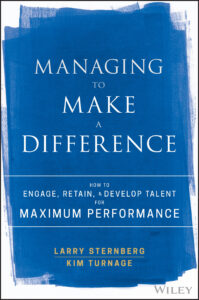Make a Difference
If you’re a new manager, you may find yourself in unfamiliar territory faster than you can imagine. How do you handle the gossiping employee? Or the top performer about to jump ship? How do you develop a high-performance team?
Larry Sternberg and Kim Turnage have literally packed numerous tips, strategies, tools and techniques for managers into the pages of their new book, Managing to Make a Difference: How to Engage, Retain, & Develop Talent for Maximum Performance. I recently spoke with Larry about their new work.
Why Employee Orientation is All Wrong
Your book starts out saying that we have employee orientation all wrong. We too often start with scare tactics and explaining what will result in termination. What does this do to new employees?
Frankly, the gratuitous negativity turns people off. The new employer is building the case for termination on day one! Also, it’s just plain boring. Negative and boring are not strategies to increase engagement and positivity about starting a new job.
You might say that these kinds of statements are necessary in our litigious society. We happen to disagree with that point of view. But even if we were to agree that they are necessary, they diminish your efforts to engage and retain people.
Imagine you’re dating someone, and you start a discussion about being exclusive and moving in together. The other person replies, “I’d love to do that! But first I want to make sure you understand the reasons I might decide to end this relationship.” How would that make you feel?
Go Ahead: Get Close to Your Team
I loved your advice on getting close to people. I’ve long advocated this. What are the benefits of getting close to people at work?
When you cultivate close, positive relationships with your employees (and among your employees), every employee spends his day with people he really likes and cares about. This increases job satisfaction, engagement and morale. Teamwork improves because employees are more likely to go the extra mile for people they care about. When problems occur, employees with good relationships will resolve them more easily. A leader who has close relationships with her employees can exert more influence on them without using her power. For instance, when she asks for extra effort, they’re more likely to give it.
Talk about the importance of setting expectations.
Experiments have established that the expectations of a leader have a powerful impact on the performance of a team. Simply put, people will live up or down to the expectations of a leader. For instance, teachers who think that girls tend not to excel at math and science produce fewer girls who are interested in math and science. Leaders who expect their employees to be extraordinarily hard working, productive and positive get more of that from their people.
The key is that the expectations must be based on the leader’s sincere belief in the potential of their people. It is a truly fortunate individual who has a leader, mentor or coach who passionately believes in his potential to excel. When the expectations emanate from that place, the leader can change lives.
Create a Sense of Urgency
Creating a sense of urgency: Why is this important? How do you create it?
A person’s sense of urgency reveals what and who is important to her. If an employee has a need, the greater a leader’s sense of urgency to meet that need, the more important that employee feels. I once worked for a company president who always interrupted whatever he was doing to take his wife’s call. He had a remarkable sense of urgency to make himself available to his wife.
 Every person has a sense of urgency about the things that are important to him. When you think that someone doesn’t have any sense of urgency, it is almost certain that the problem is one of focus. That person doesn’t have a sense of urgency about something that’s important to you. You probably don’t need to create a sense of urgency. Instead, you need to direct a person’s sense of urgency to focus on the “right” priorities.
Every person has a sense of urgency about the things that are important to him. When you think that someone doesn’t have any sense of urgency, it is almost certain that the problem is one of focus. That person doesn’t have a sense of urgency about something that’s important to you. You probably don’t need to create a sense of urgency. Instead, you need to direct a person’s sense of urgency to focus on the “right” priorities.
You must teach your employees what the right priorities are according to your organization’s values. For instance, when I worked for The Ritz-Carlton Hotel Company, one of our standards was that when a guest asked for directions to some location inside the hotel (like the men’s room), we would escort the guest rather than just give verbal directions. On one occasion I was 30 minutes late to a meeting because numerous guests kept asking me directions. According to our company values, my urgency about escorting guests trumped my urgency to get to the meeting on time.
There are numerous occasions in which you assign a task or a project to an employee, but you don’t know what’s legitimately competing for that person’s time and attention. In those situations, you should ask when the employee can complete the assignment, given the other things on her plate. If you need it completed faster than that, you should inquire about her other assignments so you can help her adjust her priorities so her sense of urgency is directed at the right things.
The Peter Principle. What are a few ways to avoid it?
The Peter Principle was articulated by Laurence Peter and Raymond Hull in their book, The Peter Principle: Why Things Always Go Wrong. It states that employees who perform well in their jobs get promoted, and continue to get promoted if they continue to perform well in each successive job. This process continues until an employee is finally promoted into a job in which he does not succeed. As they put it, that employee has been promoted to his level of incompetence.
 The way to avoid the Peter Principle is to stop promoting employees based on their performance in their current jobs. An employee should be promoted based on her potential to do the next job (the promotion) with excellence, not based on her past performance. Here’s a specific example. The number one sales rep is promoted to the position of sales manager. Now, instead of just selling, she is responsible for coaching and managing other sales reps. It’s a very different job. Her excellent performance as a sales rep tells us little or nothing about her potential to manage others. If she does not have managerial talent, she has just been “Peter Principled.” The employee who gets the sales manager job should be the employee with the best potential to excel at managing others. That person might not be best sales rep.
The way to avoid the Peter Principle is to stop promoting employees based on their performance in their current jobs. An employee should be promoted based on her potential to do the next job (the promotion) with excellence, not based on her past performance. Here’s a specific example. The number one sales rep is promoted to the position of sales manager. Now, instead of just selling, she is responsible for coaching and managing other sales reps. It’s a very different job. Her excellent performance as a sales rep tells us little or nothing about her potential to manage others. If she does not have managerial talent, she has just been “Peter Principled.” The employee who gets the sales manager job should be the employee with the best potential to excel at managing others. That person might not be best sales rep.
Different jobs require different talents. Performance in one’s current job is usually not a good indicator of the talent to perform a different job with excellence. Instead of basing your decision on past performance, base it on whether the person has the talent to perform the next job.
Qualities of Great Managers
What are some of the qualities of great managers?
They enjoy getting close to their people.
They care deeply about each and every employee.
They are great coaches.
They set challenging goals and have high expectations for performance.
They earn moral authority. They are great role models.
They have a clearly articulated set of values.
They demonstrate strong integrity to those values. They walk their talk.
They admire their employees.
They celebrate successes and high points.
They enjoy helping their people grow and develop.
They focus on the uniqueness of each employee.
They play to employees’ strengths.
They extend themselves to help each employee succeed.
They make each employee feel significant.
100 percent buy-in is not something to strive for, but many people can’t stop seeking it. What happens when this is the goal?
A leader who cannot stop seeking 100% buy-in winds up wasting some of her time trying to achieve that goal. Buy-in is not an ultimate goal. It is the means to some end. It’s important to ask why one seeks 100% buy-in. Let’s say you’re trying to implement a new process, system or approach. Almost certainly, you can make very good progress on the new approach without 100% buy-in. An organization always has early adopters, early majority supporters, late majority supporters and laggards. When implementing your buy-in strategies, don’t worry about the laggards. Even if they never buy-in, you can implement your new approach anyway.
This book is literally packed with best practices. What most often receives pushback and resistance?
Here are some of the most common:
- Quit trying to change people.
- Invest most of your time with your best performers.
- Go ahead and get close to your people.
- To help people grow, invest your time building their strengths rather than remediating their weaknesses.
Signs of a Healthy Culture
What are the signs in a culture of a manager doing it “right”?
Employees are upbeat and positive. There’s a lot of smiling and laughing.
Productivity is high. Employees are working hard.
People like each other.
Employees like their boss.
Employees like their jobs and roles.
Absenteeism is low.
Retention is high.
Other employees want to work on this team.
This team has a tangible esprit de corps.
The Power of Gratitude
You end with gratitude. Would you share your observations on its power?
 It is difficult to overstate the power of gratitude. Research studies show a strong correlation between gratitude and happiness. Yet people are less likely to express gratitude at work than almost anywhere else. Sincerely expressing gratefulness enriches both the speaker and the recipient. Focusing on the blessings for which one can be grateful is a choice. A person can cultivate the habit of expressing gratefulness, not only to themselves, but also to others. If this interview encourages people to learn more about gratefulness and to increase their practice of gratefulness, my co-author Kim Turnage and I will feel like we have made a positive difference. Thank you for the opportunity.
It is difficult to overstate the power of gratitude. Research studies show a strong correlation between gratitude and happiness. Yet people are less likely to express gratitude at work than almost anywhere else. Sincerely expressing gratefulness enriches both the speaker and the recipient. Focusing on the blessings for which one can be grateful is a choice. A person can cultivate the habit of expressing gratefulness, not only to themselves, but also to others. If this interview encourages people to learn more about gratefulness and to increase their practice of gratefulness, my co-author Kim Turnage and I will feel like we have made a positive difference. Thank you for the opportunity.
For more information, see: Managing to Make a Difference: How to Engage, Retain, & Develop Talent for Maximum Performance.

